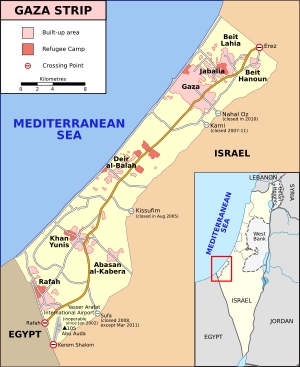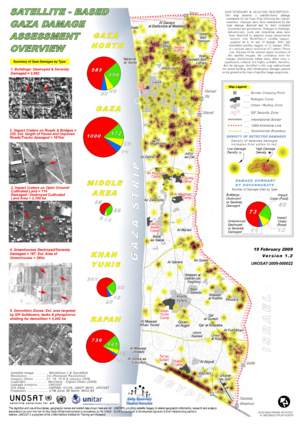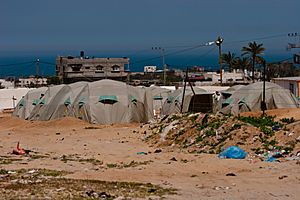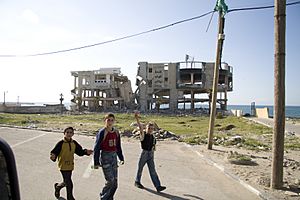Gaza War (2008–2009) facts for kids
Quick facts for kids Gaza War |
|||||||
|---|---|---|---|---|---|---|---|
| Part of the Gaza–Israel conflict | |||||||
 Map of Gaza and Israel border |
|||||||
|
|||||||
The Gaza War was a three-week conflict between Palestinian groups in the Gaza Strip and the Israel Defense Forces (IDF). It started on December 27, 2008, and ended on January 18, 2009. This conflict is also known as Operation Cast Lead in Israel. In the Muslim world, it is sometimes called the Gaza Massacre, and Hamas called it the Battle of al-Furqan. The fighting led to many deaths, with 1,166 to 1,417 Palestinians and 13 Israelis losing their lives.
What Led to the Conflict?
The Gaza Strip is a small piece of land on the coast of the Mediterranean Sea. It shares borders with Egypt and Israel. After Yassar Arafat died in 2004, a ceasefire agreement was signed in 2005. This agreement helped stop a period of violence called the Second Intifada. Many Palestinian groups, including Hamas, agreed to this ceasefire.
Israel completed its plan to remove its soldiers and settlers from Gaza in 2005. However, Israel still controlled Gaza's airspace and sea. It also limited how people and goods could move in and out of Gaza. Because of this, many groups, like the United Nations, still see Israel as controlling Gaza.
Hamas stopped firing rockets towards Israel for 14 months after the 2005 ceasefire. But in June 2006, Israeli naval shelling hit a Gaza beach, killing seven civilians. This event led to more tensions.
In January 2006, Hamas won the Palestinian elections. This surprised many, including the United States. Other countries and groups, like the United States, Russia, United Nations, and European Union (called the Quartet), said they would only help the Hamas-led government if it agreed to nonviolence and recognized Israel. Hamas refused these demands, saying they were unfair. This led to the Quartet stopping its aid and Israel putting economic limits on Gaza.
In June 2007, Hamas took control of Gaza from another Palestinian group called Fatah. After this, Israel started a blockade by land, air, and sea. This meant only humanitarian supplies were allowed into Gaza. Palestinian groups tried to get around this blockade using tunnels, some of which were used to bring in weapons.
Between 2005 and 2007, Palestinian groups in Gaza fired about 2,700 rockets into Israel. These attacks killed four Israeli civilians and injured 75. During the same time, Israel fired over 14,600 artillery shells into Gaza. These attacks killed 59 Palestinians and injured 270.
How the War Unfolded
A six-month ceasefire between Israel and Hamas ended on November 4, 2008. This happened when Israeli soldiers raided central Gaza to destroy a tunnel. Several Hamas fighters were killed. Israel said this was to stop Hamas from kidnapping soldiers. Hamas said it was a violation of the ceasefire and fired rockets into Israel in response. Efforts to restart the ceasefire failed.
On December 27, Israel began Operation Cast Lead. Its goal was to stop the rocket fire. First, Israel launched air attacks on police stations, military targets, and government buildings in Gaza. These attacks hit crowded cities like Gaza City, Khan Yunis, and Rafah. After these attacks, Palestinian groups fired more rockets in return.
On January 3, Israeli ground troops entered Gaza. By January 5, they were operating in the crowded city areas. In the last week of the fighting, Israel mostly hit targets it had already damaged. It also attacked Palestinian groups launching rockets. Hamas increased its rocket and mortar attacks on Israeli cities, reaching Beersheba and Ashdod for the first time.
Israeli leaders decided not to go deeper into Gaza. They were worried about more casualties and growing international criticism. The conflict ended on January 18. Israel first announced a ceasefire, and Hamas announced its own ceasefire 12 hours later. Israeli soldiers fully left Gaza by January 21.
In 2009, a special United Nations team, led by Justice Richard Goldstone, released a report. It said that both Palestinian fighters and Israeli soldiers might have committed war crimes. The report suggested bringing those responsible to justice. In 2011, Goldstone said he no longer believed Israel purposely targeted civilians. However, the other authors of the report disagreed with his new view. The United Nations Human Rights Council asked Israel to repair damages. By 2012, 75% of destroyed civilian homes had not been rebuilt.
Aftermath of the War
The war was seen as a military win for Israel and a big loss for Hamas.
Besides the many deaths, the war caused a lot of damage to Gaza's economy, industries, and health services. The United Nations Development Programme warned that the attacks would have long-lasting effects. Many thousands of people in Gaza lost their homes and ways to make a living.
Early estimates said Gaza lost nearly $2 billion in assets. About 4,000 homes were destroyed. Israeli forces destroyed 600 to 700 factories, small businesses, and workshops. They also destroyed 24 mosques, 31 security buildings, and 10 water or sewage lines. The World Health Organization reported that 34 health facilities, including 8 hospitals, were damaged. Over 50 United Nations buildings were also damaged. In 2010, Israel paid $10.5 million to the United Nations for damage to UN property.
A satellite study of Gaza showed widespread damage. It found 2,692 destroyed or badly damaged buildings. There were 220 impact craters on roads and bridges. About 167 km (104 mi) of roads were damaged. Over 2,100 hectares (21 km²) of land had impact craters. Also, 187 greenhouses were destroyed, and 2,232 hectares (22.32 km²) of land were cleared by Israeli bulldozers and tanks.
After the war, Gaza saw more health problems. Doctors from Norway said they found traces of depleted uranium in some wounded Gaza residents. This material is used in some weapons. Lawyers who took soil samples from Gaza said some areas had up to 75 tons of depleted uranium. The Israeli government denied using it, and the United Nations started an investigation. Israel also first denied using white phosphorus during the war but later admitted it used it to cover troop movements.
The World Food Programme and other groups reported that 35% to 60% of Gaza's farming industry was ruined. Water sources, greenhouses, and farmland were badly damaged. It is thought that 60% of the farmland in northern Gaza might no longer be usable. More than 50,800 people in Gaza were left without homes. Businesses and public services also suffered huge damage. Palestinian business owners said 219 factories were destroyed or badly damaged.
After the conflict, many countries and organizations sent help to Gaza. The European Union, the Organisation of the Islamic Conference, and over 50 nations donated humanitarian aid. This included the United States, which gave over $20 million.
A report by the World Health Organization found that 48% of Gaza's health facilities were damaged or destroyed. This included 15 hospitals and 41 primary health care centers. Also, 29 ambulances were damaged or destroyed. Injured patients needing special care outside Gaza were taken through the Egyptian Rafah Border Crossing. One year after the ceasefire, about 20,000 people were still displaced from their homes.




